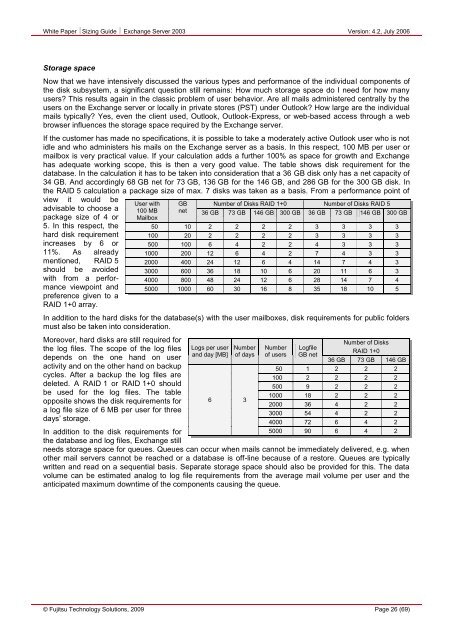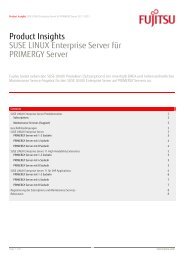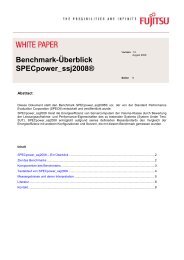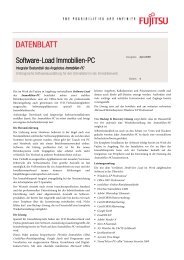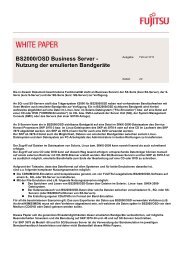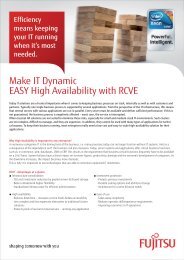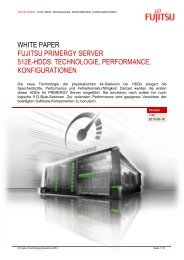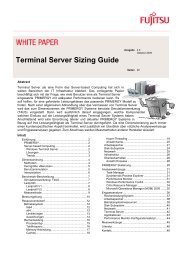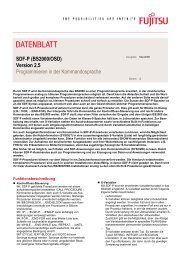Sizing Guide Exchange Server 2003 - Fujitsu
Sizing Guide Exchange Server 2003 - Fujitsu
Sizing Guide Exchange Server 2003 - Fujitsu
You also want an ePaper? Increase the reach of your titles
YUMPU automatically turns print PDFs into web optimized ePapers that Google loves.
White Paper <strong>Sizing</strong> <strong>Guide</strong> <strong>Exchange</strong> <strong>Server</strong> <strong>2003</strong> Version: 4.2, July 2006<br />
Storage space<br />
Now that we have intensively discussed the various types and performance of the individual components of<br />
the disk subsystem, a significant question still remains: How much storage space do I need for how many<br />
users? This results again in the classic problem of user behavior. Are all mails administered centrally by the<br />
users on the <strong>Exchange</strong> server or locally in private stores (PST) under Outlook? How large are the individual<br />
mails typically? Yes, even the client used, Outlook, Outlook-Express, or web-based access through a web<br />
browser influences the storage space required by the <strong>Exchange</strong> server.<br />
If the customer has made no specifications, it is possible to take a moderately active Outlook user who is not<br />
idle and who administers his mails on the <strong>Exchange</strong> server as a basis. In this respect, 100 MB per user or<br />
mailbox is very practical value. If your calculation adds a further 100% as space for growth and <strong>Exchange</strong><br />
has adequate working scope, this is then a very good value. The table shows disk requirement for the<br />
database. In the calculation it has to be taken into consideration that a 36 GB disk only has a net capacity of<br />
34 GB. And accordingly 68 GB net for 73 GB, 136 GB for the 146 GB, and 286 GB for the 300 GB disk. In<br />
the RAID 5 calculation a package size of max. 7 disks was taken as a basis. From a performance point of<br />
view it would be<br />
advisable to choose a<br />
package size of 4 or<br />
5. In this respect, the<br />
hard disk requirement<br />
increases by 6 or<br />
11%. As already<br />
mentioned, RAID 5<br />
should be avoided<br />
with from a performance<br />
viewpoint and<br />
preference given to a<br />
RAID 1+0 array.<br />
User with<br />
100 MB<br />
Mailbox<br />
In addition to the hard disks for the database(s) with the user mailboxes, disk requirements for public folders<br />
must also be taken into consideration.<br />
Moreover, hard disks are still required for<br />
the log files. The scope of the log files<br />
depends on the one hand on user<br />
activity and on the other hand on backup<br />
cycles. After a backup the log files are<br />
deleted. A RAID 1 or RAID 1+0 should<br />
be used for the log files. The table<br />
opposite shows the disk requirements for<br />
a log file size of 6 MB per user for three<br />
days‟ storage.<br />
In addition to the disk requirements for<br />
the database and log files, <strong>Exchange</strong> still<br />
GB<br />
net<br />
Logs per user<br />
and day [MB]<br />
Number of Disks RAID 1+0 Number of Disks RAID 5<br />
36 GB 73 GB 146 GB 300 GB 36 GB 73 GB 146 GB 300 GB<br />
50 10 2 2 2 2 3 3 3 3<br />
100 20 2 2 2 2 3 3 3 3<br />
500 100 6 4 2 2 4 3 3 3<br />
1000 200 12 6 4 2 7 4 3 3<br />
2000 400 24 12 6 4 14 7 4 3<br />
3000 600 36 18 10 6 20 11 6 3<br />
4000 800 48 24 12 6 28 14 7 4<br />
5000 1000 60 30 16 8 35 18 10 5<br />
Number<br />
of days<br />
6 3<br />
Number<br />
of users<br />
Logfile<br />
GB net<br />
Number of Disks<br />
RAID 1+0<br />
36 GB 73 GB 146 GB<br />
50 1 2 2 2<br />
100 2 2 2 2<br />
500 9 2 2 2<br />
1000 18 2 2 2<br />
2000 36 4 2 2<br />
3000 54 4 2 2<br />
4000 72 6 4 2<br />
5000 90 6 4 2<br />
needs storage space for queues. Queues can occur when mails cannot be immediately delivered, e.g. when<br />
other mail servers cannot be reached or a database is off-line because of a restore. Queues are typically<br />
written and read on a sequential basis. Separate storage space should also be provided for this. The data<br />
volume can be estimated analog to log file requirements from the average mail volume per user and the<br />
anticipated maximum downtime of the components causing the queue.<br />
© <strong>Fujitsu</strong> Technology Solutions, 2009 Page 26 (69)


